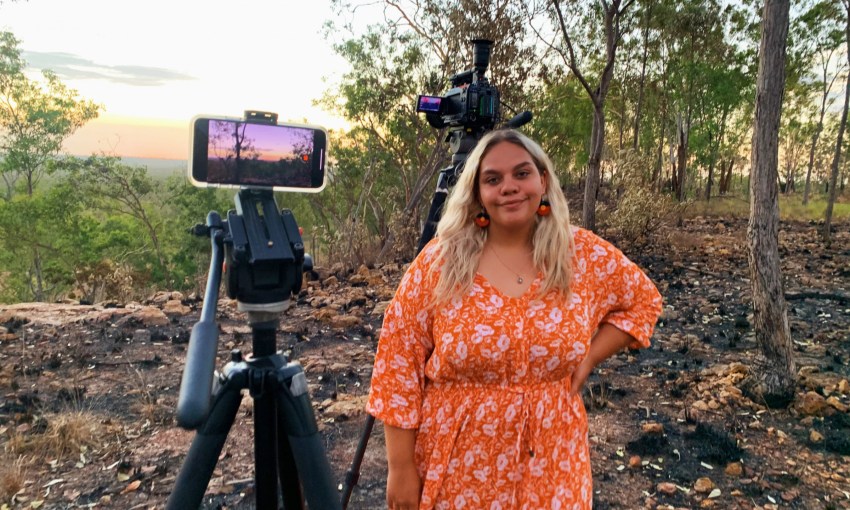University of Adelaide student Zoe Fitzpatrick is creating an informational video in Indigenous language Garrwa and English to promote the use of both Aboriginal and Western medicinal practices.
A dual-language educational health video connecting two worlds
Yantuwa and Garrawa woman Zoe Fitzpatrick is passionate about Aboriginal health. This is because, from a young age, she watched her dad work as a remote area doctor. He left a lasting impact on the rural communities he was immersed in.
“Every small town in the NT, he’s worked at,” Zoe tells CityMag, “and it’s always been remote Aboriginal clinics.”
Zoe Fitzpatrick hails from NT but is based in Adelaide while she completes her nursing studies.
She’s also an artist. Check out her Instagram here.
“I come across people today and I tell them who I am and I tell them my last name, and they’re like, ‘Oh, are you Peter’s daughter?’ Somehow he’s helped them with something in their health journey. He’s done something for them and it’s really nice to hear that.”
Zoe talks to us from Borroloola in the Northern Territory, her hometown. Borroloola has a population of 1,000 people, predominantly Aboriginal Australians. She’s in the NT to produce a bilingual video about Aboriginal and Western health practices, and is on the ground collecting research, including by speaking with elders.
At the beginning of the year, Zoe was given a scholarship by the Menzies School of Health Research in Darwin to create a promotional health video. The aim of the video is to promote both Aboriginal and Western health practices being used in unison.
“It’s mainly targeted to Aboriginal people, but it can be informative to anyone,” Zoe says, “[so] one part will be how to be healthy in an Aboriginal way, and the other will be about being on Country and out there with your family – that’s really good for your mental health.”
Zoe is speaking from experience. When she’s not in the NT, she’s about 3,000km away studying in Adelaide. She’s at the tail end of a four-year nursing degree, but says when she’s in Adelaide, she “yearns to be home”.
“A lot of Aboriginal people feel that,” Zoe says.
“It’s important to come back and spend time on Country for your mental health because every time I come back, I just feel like I’m refreshed. And then I can go back to the city, do what I need to do and come back again when I need to. You charge yourself up again, once you come back onto Country.”
The video Zoe is making will include an opening statement spoken in Garrawa, the main language of five spoken in Borroloola, while the remainder of the video will be in English.
Though it’s targeted at Indigenous communities, the video is predominantly in English because Zoe hopes everyone will have an opportunity to learn from it.
Eight years ago, a group of Ngangkaṟis (Indigenous healers) from the Central Desert APY Lands formed the Aṉangu Ngangkaṟi Tjutaku Aboriginal Corporation. Years later, the South Australian government incorporated some of these healers into the public health system. Now Ngangkaṟis can be found at six major South Australian hospitals, and offer a range of services including cleansing and traditional counselling.
Zoe recognises the importance of this move, but argues Indigenous communities already have their own ways of healing. She wants the video to inform non-Indigenous people about this wealth of knowledge, so they might recognise a brewed tea or balm can be just as therapeutic as a packet of pills.
But she also understands Western medicine shouldn’t be abandoned. Australia has changed a lot over the last 300 years, she says, and it’s necessary for Aboriginal people to go to the clinic, get check-ups and take their medication.
“This video is informing them how to do that,” Zoe says.
The point being made, though, is there is merit in drawing on both sets of knowledge.
“I spent yesterday with my elders, and we went out bush all day, and along the way we found three different bush medicine trees, ” Zoe explains.
“Talking to them, they said ‘Aboriginal people where here for over 60,000 years, and they have their ways of when they got sick, they knew what to do.’ In tribes they had a doctor, in a way, there was someone they could go to for specialised sort of care.
“They put the sick people under sand with eucalyptus leaves when they had colds. There are some amazing stories that I have been told by my elders about the bush medicine. It’s incredible. And I can’t wait for other people to see it and hear it.”
The video will be released by the end of the year. Keep an eye on Zoe Fitzpatrick’s social media for more info.




